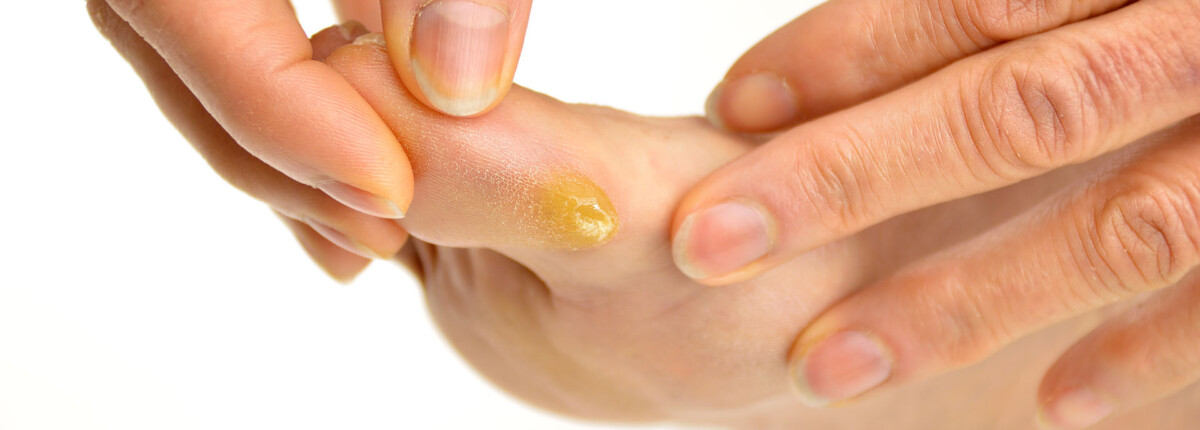Calluses are typically not serious but can cause discomfort or sometimes even pain, due to the pressure exerted on the underlying tissues by the thickened lump of skin. In order to keep or restore your personal comfort, it is important to treat your calluses.
How to treat calluses?
Calluses are reactions to excessive pressure on the heel, the forefoot or the palm of your hand. By eliminating the source of pressure, they will probably resolve on their own. If you decide to start treating your callus, keep in mind that this can be a long process and it may not be achieved in a single day.
Refrain from using sharp objects to cut big chunks of callus since injury may occur and lead to bleeding and/or infection.
Please note that, if you have insensitive skin due to poor circulation, diabetes or nerve damage, you should consult a doctor or chiropodist before treating your calluses.
Remove calluses:
- Step 1: soften the callus – Calluses are very thick and stiff so it is recommended to first soften them up. You can achieve this by soaking the affected part (typically your hand or your foot) in warm and soapy water. Adding Epsom salts in the soaking solution might have an additive effect. You can also use commercially available exfoliating creams to soften the skin. Another option is to use over-the-counter liquids or ointments containing salicylic acid, which helps to dissolve the keratin structure that makes up the dead skin. These treatments should only be used cautiously as the salicylic acid might irritate the surrounding healthy skin. If irritation occurs, you should ask your pharmacist for advice.Alternatively, you can use COMPEED® Callus plasters. They contain a special gel (hydrocolloid technology), which provides moisture while protecting and cushioning the callus. They will relieve discomfort or pain should you be experiencing any.
- Step 2: File the callus with a pumice stone or foot file. – Once the callus is softened, you can file it with a pumice stone. Dip the pumice stone in water and then gently remove the dead skin by circular or sideways motions. You can also use a foot file as an exfoliating tool. Pay attention not to remove too much skin as this might cause bleeding and infection. Instead, remove only small amounts and repeat the action regularly until the callus disappears.
- Step 3: keep your skin moisturised – After filing the callus, it is important to moisturise the trimmed skin in order to keep it soft. Any skin lotion will do the job. Applying a COMPEED® Callus plaster will help to keep the callus wound moisturised and help it to heal.
Prevent calluses from developing and avoid reoccurrence:
To avoid calluses on the feet, you need to reduce the point of pressure and rubbing on your feet and hands.
Limit yourself as much as possible from wearing shoes that alter your weight distribution such as high-heeled or high-arched shoes. If your job requires you to wear this type of shoe, try to take some of the pressure off your feet by walking to and from the office in well-fitting, comfortable shoes or trainers. Try to decrease heel height as much as possible.
Take care of your shoes by repairing them or replacing them regularly. Worn-out soles typically are not very good at cushioning your feet. Also if you notice that the soles or heels of your shoes tend to wear unevenly, you might want to talk to a chiropodist or podiatrist about corrective shoes or insoles.
Calluses can happen on hands, so wearing protective, padded gloves can help if you use tools.
When should I seek medical advice?
If the callus is very painful, or if you have diabetes, fragile skin, or circulatory problems, it is best to consult a doctor or a healthcare professional specialising in footcare such as a podiatrist.
A foot or posture specialist may help correct abnormal gait by checking your footwear or identify an underlying bone structure problem. In the latter case, you may be referred to undergo an X-Ray or possibly a surgical procedure.
A podiatrist may remove some of the hard skin using a scalpel. Do not attempt to do this at home.
If there is an infection or a risk of infection, you may be advised to visit your doctor, who may prescribe an antibiotic ointment. Red and swollen skin around the callus can indicate an infection.







